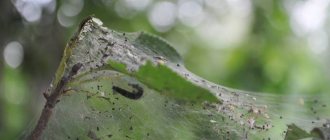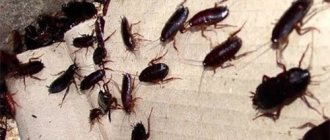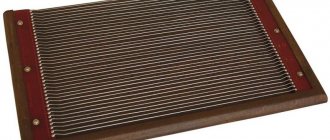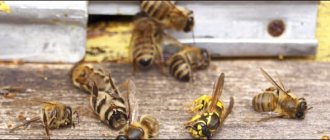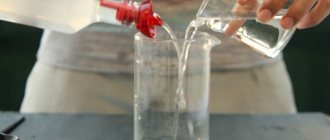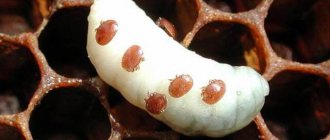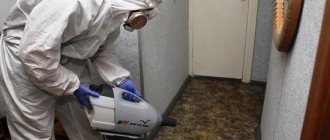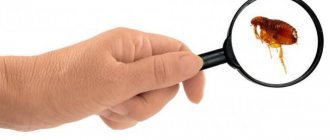In search of sweet juice, the bee lands on flowers and honey plants, which may be inhabited by parasites. One of them is the Varroa mite, which feeds on hemolymph and causes varroatosis. Without the participation of a beekeeper who carries out the prevention and treatment of beneficial insects, the entire swarm dies. The necessary treatment of bees against mites (according to experts) is best done in the fall after honey collection before the onset of the first frost.
The well-being of bees is the main concern in beekeeping. Bee colonies are often the target of mites. Infection leads to the death of bees, weakens colonies, and reduces their quality. In this case, the productivity of the apiary decreases.
Beekeeping is experiencing great financial loss. It is the spring work of a beekeeper that will help the family maintain health and performance throughout the season.
General characteristics of the disease
Varroatosis is a dangerous pathology. It affects any bees - both adults and larvae. The danger of the disease is that at the initial stage it can rarely be detected due to the absence of obvious clinical signs.
Varroatosis is a quarantine disease, since the degree of its contagiousness is very high.
Insects affected by varroa do not form a club in the fall. They do not tolerate the winter period well. It is possible to awaken in the first half of winter.
Classification of types of mite treatment
There is a standard classification of types of tick treatment, including: chemical, thermal and zootechnical methods. I don’t like this overly general classification, since there is no connection to the biology of either the mite or the bee. The same chemical method includes water emulsions, wooden plates, thermal cords, steam generators, etc. I prefer another classification, which allows, after assessing the condition of the bee colony, to choose a processing method and carry it out with the greatest efficiency:
1. Treatment in a broodless state. Impact on ticks located on adult individuals. The task is to remove the mite from the bee (from the imago, from the adult insect). Processing is carried out in a broodless version. The state of colonies without brood can be natural or artificially created. There are many methods. Of course, you can use these methods even if you have brood, but the efficiency will be low.
2. Treatment in the presence of open brood. Exposure to mites near open brood. The goal is to prevent the tick from reproducing or creating obstacles to the replication of the tick. It is necessary to drive the mite away from the open brood before sealing. Thus, we obtain pure, high-quality closed brood.
3. Treatment in the presence of closed brood. Effects on mites in sealed brood. The task is to destroy the mite inside the closed brood or interrupt the reproduction and feeding of mites inside the closed brood.
A very important note: Mite treatment should not be an accompanying element of additional workload for the beekeeper, causing internal rejection of unwanted work. And a clearly planned operation, and for the entire beekeeping season: spring, summer and autumn.
Moreover, it is very useful to link the mite treatment schedule with the honey collection schedule, the queen flight schedule, the preparation schedule for wintering, and if you have paternal families, then with the mite treatment schedule for drones. Below, in the description of some methods, I pay even more attention to the conditions of honey collection and flying around the queens than to treatment against ticks. But this is a necessary measure in order to understand the intricacies of a particular processing method.
Now, based on the above classification, let's look at various options for treating bee colonies against Varroa mites. Must be linked to the annual development cycle of bees.
The sequence of actions will be as follows. Let's distribute processing methods into groups. Let's look at the goals, advantages and disadvantages of each in detail. And finally, I will give several diagrams linked to the bee colony development calendar, which I personally use.
Once again I will say that, based on the biology of tick development, it is possible to distinguish three treatment options that have different goals and affect the tick in different ways.
Broodless state.
The goal is to remove the tick from adult insects:
a. Drop-jet treatment of bees in complex chemical streets. drugs. The treatment is carried out quite quickly - spraying the streets of bees with a stream of the drug. The drugs cause the death of mites and their falling to the bottom of the hive. The preparations have a certain toxicity, and there is a danger of toxic substances getting into beekeeping products. Weaken the immunity of bees.
b. Drop-jet treatment of bees in alleys with solutions of acids, both natural and synthesized. Treatment is carried out by irrigating the bee streets or spraying the bees on the frames. The preparations create an atmosphere that causes mites to fall to the bottom of the hive, but cause partial death. To prevent the return of mites to bees, it is necessary to process at temperatures below +10 degrees, or use mite traps at the bottom. There is also undesirable penetration of drugs into beekeeping products.
c. Irrigation of bees on frames with herbal infusions. Treatment is carried out by irrigating the bee streets or spraying the bees on the frames. Wormwood, pine needles, pepper, celandine, etc. are used. An excellent remedy as an auxiliary or in combination with biological methods. Can be used almost any time, without focusing on honey collection.
d. Sprinkling with pine powder. The treatment is carried out by sprinkling powder from dried pine needles on the streets of bees. In my opinion, the process of preparing the powder is too labor-intensive.
e. Fumigation. The drugs create an atmosphere that causes mites to fall to the bottom of the hive and die. Quite toxic. Weaken the immunity of bees.
f. Heat treatments in heat chambers. Very good results in getting rid of ticks. In my opinion, there are two main disadvantages: the high cost of the equipment and the length of the processing cycle. I recommend removing the uterus before processing if the sterile state was not natural, but was ensured by artificial isolation of the uterus. In the latter case, the uterus is large and ready for oviposition. In this situation, it is not adapted to either flying or overheating.
g. Treatment with phytoncides, use of strong-smelling herbs, resins in their natural form. Wormwood, pine needles, resins, etc. are used. They are placed on frames and in the space under the frame. An excellent remedy as an auxiliary or in combination with biological methods. Can be used almost any time, without focusing on honey collection.
Open brood.
The goal is to prevent the mite from reproducing by driving the mite away from the open brood before sealing or by reducing the amount of open brood to zero:
a. Installation of acaricidal strips. The strips are placed between frames with open brood. The drug has a long-lasting effect until complete evaporation. Drives mites away from open brood before sealing, partially causing the mite to fall to the bottom of the hive. Very convenient and quick to use. Toxic. Not used during honey collection.
b. Using fertilizers with pine extract, red pepper, horsetail, wormwood, etc. Used during the development of families. Bees deposit scented nectar near exposed brood, creating the necessary relative humidity. Drives away mites from the brood and prevents its reproduction.
c. Treatment with phytoncides, use of herbs, resins in their natural form. Wormwood, pine needles, resins, etc. are used. They are placed on frames and in the space under the frame. An excellent remedy as an auxiliary or in combination with biological methods. Can be used almost any time, without focusing on honey collection. Even artificially synthesized oils for baths and saunas work great; pieces of foam rubber soaked in oil are laid out on top of frames and thrown to the bottom of the hive.
d. Complete isolation of the uterus and leaving it in the family. (*)
The principle applies here: “no open brood - no mite reproduction.” This method is interesting when it is planned to limit the queen’s egg laying to reduce mite reproduction in the late summer brood. As a matter of fact, it is proposed to exclude the August breeding of the bee by isolating the queen in July. This will allow the number of ticks that was in July to remain unchanged. This option is possible if there is enough brood in July for wintering.
There is another advantage to this method. Traditionally, in normal families, in the conditions of the Moscow region, the queen lays the last drones in July. It is possible, of course, to force the queen to lay a drone in August, but this will be the purposeful actions of the beekeeper, using a certain technology.
The mite prefers drone brood as it is the most nutritious. There he can raise one more generation - the sealed brood phase is 15 days versus 12 for bees. And the tick rushes there to reproduce. If you remove the drone brood, thus removing the mite, and isolate the queen, preventing her from laying the next generation of bee brood, then conditions will be created in the colony to make it impossible for the mite to reproduce further.
I repeat once again that to use such technology it is important to fulfill one condition. At the time of isolation of the queen, the colony should have a sufficient number of frames with closed brood for wintering. The bee emerging from this brood will form the wintering club.
e. Selection of the queen from the family and its subsequent return. Or with a replacement for a barren uterus. Or replacing it with a mother liquor.
This is an example of the inhibition of mite reproduction due to the lack of open brood and the further transfer of the bee colony to a broodless state for further processing. This option is used, for example, to obtain May honey. If by May 1 your family has reached a strength of 1.5-2 Dadan corps, you can change the queen to a queen cell. You exchange open brood for sealed brood, using a helper family as a brood supplier. And after 12 days you will receive a colony state without brood. The uterus flies around the 15th-20th.
The tick's reproduction stopped for 15-20 days. Plus, you can use the resulting state of the bee colony by May 12 for mite treatment using one of the methods used in the absence of brood. If the weather is good, you will get May honey up to 30 kg.
Closed brood.
The goal is to destroy the mite or interrupt the reproduction and feeding of mites inside the closed brood:
a. Gravity method.
The idea of this method is based on inhibiting the reproduction of a mite that has already penetrated the closed brood. With a daily change in the direction of the Earth's gravitational field, the mite brood is not fed, the mite queen remains alive, but the young generation does not develop. In beekeeping practice, the following were proposed: turning the frames upside down with changing the position of the hangers, a rotating lower body or a rotating nest with frames.
In my interpretation, the technology for using this idea is as follows:
- Processing is carried out when the family is in the same building. The dates are April and the end of August. If there are more than one bee building, we still place them in one.
- I teach bees to fly only through the upper entrance.
- I transfer the frames in the case to a warm skid. Technically, I simply turn the hive sideways forward, an upper entrance hole is also drilled in the side at the same level, the bees begin to fly through it, and the other entrance closes. The lid is fixed in any way so that it does not fall off when tipped over, you can use screws or rope
- And finally, I drop the hive on its side. The position of the frames turns out to be rotated 90 degrees relative to the previous position. The entrance moves 30-40 cm to the side.
- A day later I drop the hive on the other side. The position of the frames changes 180 degrees relative to the previous position. The entrance goes to the side by 60-80 cm. Of course, the hive can be raised to ensure that the position of the entrance coincides.
- And so on for two weeks. We obtain no increase in the number of mites after the bees emerge from the closed brood. In the future, it is possible to process it in a broodless version using one of the methods. Or combination with treatment against mites on open brood.
b. Biological (zootechnical) method - destruction of drone brood.
The mite for reproduction prefers drone brood to bee brood more than 10 times, and in some periods of the life of bee colonies it uses only drone brood. Therefore, its removal, its cutting out, significantly reduces the number of ticks in the family. This is the most natural, simple, and safe for bees and bee products method of killing mites. The main task is to place construction frames strictly according to schedule and remove them on time.
c. Biological (zootechnical) method - destruction or selection of bee brood.
The opinion about the benefits of removing the first and last brood in order to get rid of the mite is erroneous.
In spring, the mite is in no hurry to crawl out of the tergites of bees, since the most optimal conditions for reproduction occur with the appearance of drone brood. And in the fall, during the normal breeding cycle of the family without stimulating autumn egg production, the queen stops sowing at the first frost, even in August. If you remove the brood, you will be left with nothing. It makes sense to use this option for mite control when you are confident that the existing generation of bees is long-lived.
An example from my practice. Until the end of August I keep the nucs in 16 frame beds: 4 pcs. 1 - 4 standard frames in one hive, across the partitions. During the summer, the cores grow from one to four frames. I usually select the last queens in mid-August; I select three out of four. Therefore, I unite the four former nuclei into one family with the last queen. There is a significant nuance here. Usually, the nucs are not treated for mites during the summer, this is due to the desire not to harm young queens, lack of time, etc. It is interesting and very important that the cycle of mite reproduction in the nucs coincides with the cycle of flying around the queens and seeding.
Let’s assume that the first queen of the current year in a particular nucleus flew around on May 20th.
The number of bee frames is one. I let the uterus sow, and on May 30 I sell it. The entire mite, even if there were very few of them, rushes into the closing brood in the amount of one frame for reproduction.
The next queen, placed in early June, is guaranteed to fly around on the 15th. It will be implemented on June 25-20. The number of frames has already reached 3 - the core expanded as needed. By June 15-20, the multiplied mite will emerge from the closed brood along with the newborn bee and again rushes into a new sowing, now of the second queen. Etc. Until August.
Thus, a situation is created: while the queen is not sowing, the mite multiplies and comes out, the queen sows - the mite rushes into the sowing to reproduce. As a result, in August we have almost completely infected closed brood in each nucleus, and the bee that is in the hive is ready for wintering and has a fully developed fat body. Because there was little brood requiring royal jelly feeding. When combining colonies into one, it is quite possible to remove all the bee mite brood and process it using one of the methods for a broodless state. It is important to prevent the queen from laying further eggs by cooling the nest.
Thus, it is very convenient to distribute mite treatment methods according to the type of brood part of the bee colony. It is also convenient and even necessary to correlate the processing schedule with the schedule of honey collection, flight of queens and preparation for winter.
Goals of autumn processing
Autumn prevention helps reduce the risk of varroatosis, which develops throughout the winter. This procedure makes it possible to minimize the losses of the bee colony, since infected individuals are often unable to survive wintering and do not survive until its end.
Tick-borne parasites predominantly settle in the abdominal cavity of insects, between segments, remaining there until the brood develops.
Preventive actions are carried out after the end of the main honey collection.
Symptoms and diagnosis of infection
The presence of a mite in the hive is determined primarily by the behavior of the bees and their appearance. They become lethargic because they lose a lot of protein, which is sucked out by parasites. Insects are unable to fully collect and bring the required amount of honey and pollen for their livelihoods.
Only emerging young individuals may have deformed bodies and underdeveloped wings. There is no presence of brood within the framework. When affected by parasites, you can observe a large number of worker bees crawling near the flight board.
Varroa can be seen with the naked eye, and to identify other (very small) representatives of this species, it is necessary to submit dead bees to the laboratory for research.
Treating bees against mites in the fall
The presence of a mite in the hive is indicated by the behavior of striped insects and their appearance. The bees become more lethargic due to the loss of large amounts of protein and do not work as hard as usual. Young infected individuals may have underdeveloped wings or deformed bodies. If the Varroa mite is quite easy to spot with the naked eye, then with other varieties of the parasite everything is somewhat more complicated. To identify them, dead bees should be sent to the laboratory for appropriate research.
On a note. Treatment for mites will have the best effect if done in the fall in preparation for winter, after the honey pumping is completed.
Practice shows that one dose is not enough to cure a swarm and provide high-quality prevention. Therefore, even as a preventive measure, beekeepers treat bees against mites in summer and autumn or spring and autumn.
Treating bees against mites
The main routes of infection are the following:
- bee theft;
- wandering bees;
- association of families, one of which is infected;
- adding a frame with brood from a weaker colony to a strong one;
- purchasing from an unreliable seller;
- old hundred frames.
Parasites prefer to live on bees in segments of the abdominal cavity. The tick lives there during the period of brood development: that is, from spring until autumn. What is especially surprising is that despite the relatively small size of the insect, up to 7 parasites can be present on it at the same time.
When to treat
Ticks are usually located in the abdominal region between the segments. They remain in such places until the brood develops. The brooding period lasts from spring to autumn. Parasites are characterized by fairly rapid reproduction, which is why there can be up to 7 ticks per individual.
Parasitic mites are characterized by very rapid reproduction. In advanced cases, there are up to 7 mites per bee.
Ticks affect not only adults, but also brood. Therefore, means of combating varroatosis and acarapidosis must be combined. For example, it is doubtful that the plates are capable of controlling parasites on the brood.
This means that in this case, the greater effect will be from using a smoke gun or spraying acid solutions.
Preventive treatment of bees against mites is a very important measure in beekeeping, as it can significantly reduce the risk of varroatosis.
Usually this disease develops in winter. Therefore, it is recommended to treat bees in the fall, and not in the spring or summer. After all, in spring and summer insects will already be infected with parasites.
Reasons for treating bees for parasites in the fall
- at this time there are significantly fewer bees;
- in the presence of parasites in the nest, a significant weakening of the family is observed;
- the risk of developing concomitant insect diseases increases.
If you properly treat bees against mites in the fall, you can minimize the losses of the bee colony, because infected individuals most likely will not survive until spring.
If spring or summer is chosen to treat bees against mites, then such prevention will be several times less effective. Therefore, bees are not particularly disturbed in spring and summer.
General characteristics of the pest and the need for treatment
Varroa mite is a pest that harms the bee colony. It not only attaches itself to individuals and feeds on their blood, but also acts as a carrier of dangerous diseases that kill honey plants. Tick infestation significantly weakens families.
The pest has an oval, flattened brown body. Its width is 1.8 mm, length – about 1 mm. These parasites live for about 10 months. Varroa mites develop at a humidity of 70%, the optimal temperature is +34-36 degrees.
Pests attack bees. Up to 7 ticks can parasitize one individual. When they find themselves on honey plants, pathological processes begin to develop in the insect’s body. Bees become apathetic, they cannot resist various diseases due to reduced immunity.
Varroa mite: the female mite finds cells with bee brood and lays her eggs there
Unsuspecting bees seal the cells where the mite develops and begins to parasitize the pupa
The adult mite parasitizes bees, feeding on their blood and lymph. Without treatment for parasites, bees are born with developmental defects, and over time their numbers decrease
If a tick infects a larva, a small bee emerges from it. She has no fatty layer in her body, its surface is devoid of shine. Adult drones and bees affected by Varroa lose their ability to fly and are unable to fully feed their offspring.
Read about how to treat bees for varroa and whether this disease can be prevented.
How to determine if bees are infected with mites
The occurrence of parasites that appear on bees can be a serious problem for beekeepers.
Infected insects very often leave their homes, and the remaining bees die. When mites land on a bee's body, they begin to feed on insects and gradually lead to their death.
Parasites can also be carriers of various diseases that affect the insect and can be transmitted by a bite.
Signs of tick infestation
- insects become lethargic and may not fly out of the hive for a long time;
- the amount of honey decreases;
- very often the insect’s body becomes deformed, young bees have damaged or undeveloped wings;
- the number of young insects decreases; with a large number of mites, further reproduction of bees stops.
Female mites are slightly larger than a millimeter in size, brown in color, and visible on the bee’s body. Life expectancy is two to three months in summer and up to five in winter. At the same time, the individual is very hardy and, even without direct contact with bees, is capable of surviving up to 18 days inside the hive and up to five days outside.
The male mite is slightly smaller, the color of the shell is white and it can only survive inside the hive. Ticks are ready to reproduce immediately after hatching, and the male quickly dies. The female lays eggs on brood and adults, and a week later a new generation of mites appears. It is very difficult to destroy it, especially since the parasite is now rapidly becoming accustomed to insecticides.
Preparations for treatment
Chemical products often contain instructions that must be strictly followed so as not to harm the bees. Folk compositions also need to be properly prepared and used for treating hives.
Amitraz
This drug belongs to the group of acaricides and is used to combat parasites in the fall. The product is toxic, so it should be used after the last honey collection. When processing, you must follow the instructions.
Bipin
Bipin is an acaricidal drug. It is diluted to an emulsion and used to process frames 2 times with an interval of 1 week. This remedy cannot affect the quality of the product, but many beekeepers use it only when there are clear signs of weakening of the bee colony.
Thymol
Thymol is considered safe for bees, drones and the queen, but it should be used 7 days before pumping out honey and collecting other bee products. This remedy is effective not only against ticks, but also against a number of bacterial and fungal infections.
Acaricide
This drug is available in the form of a solution and plates. It is enough to treat the hive once to reduce the number of parasites.
Horseradish
Horseradish leaves and roots can be used to eliminate mites. These components should be thoroughly dried and then placed in a smoker, pumping 4 times into each house. Treatment can be carried out 1-2 times a week.
Apitak
This drug is used only in the fall, after the honey has been collected and the bees are preparing for winter.
The medicine itself is a very strong acaricide, sold in ampoules in the form of an oil suspension. The drug must be diluted strictly according to the instructions; the result will be an opaque, milky liquid.
Treatment is carried out by pouring the streets into the hive from a syringe. Treatment is carried out twice with an interval of 7 days.
Bivarool
A very effective, toxic drug for the treatment of varroatosis. Treatment is carried out in the spring before the start of honey collection, approximately 2 weeks. In the fall - after pumping.
The packaging is opened immediately before processing. The drug must be diluted strictly according to the instructions in compliance with the dosages. There are cases where non-compliance with recommendations led to mass death of bees.
The parasite very quickly gets used to chemicals, so methods and methods of treatment have to be changed frequently. Some beekeepers have found a new use for Bivarool - treating bees and houses from the parasite using a smoke gun.
It will be possible to determine how effective the treatment was only after a day, by pulling out and inspecting the pallet.
Oxalic acid
To rid the hive of parasites, you need to dilute 2 g of acid with 40 ml of water. The container with the drug is suspended in the corner above the nest for 3-5 days. The acid evaporates, which leads to the death of the mites. It is better to use this product at a temperature of +15°C...+25°C.
Plates and strips
Preparations applied to veneer plates or strips have proven themselves to be effective in treating bees against mites. They are very simple to use - the plates are simply placed in the hive for a long time, and the pieces of paper are set on fire and placed in a tray.
The most effective are strips impregnated with formicide. These are Apimol-T, Vetfor and Varrosan. Apifit and Varroades are also popular.
Essential oils
To protect bees from mites, any essential oil is suitable. As with other insects, it does not kill, but only repels parasites. Bees tolerate oils better, as they often collect nectar from essential oil plants.
Essential oils against ticks
15 g of purchased essential oil is mixed with 85 g of petroleum jelly and smeared with the composition on 2 pieces of any material: polyethylene, old oilcloth. It is important that the fat does not spread further than the substrate. One piece of oilcloth is placed under the frames with the greased side up. The other is on the frame, oil side down. The composition is updated every 5-6 days. 3-4 times are enough for the mites to go away. But after the oilcloths are removed, the parasites will sooner or later return.
Powdered sugar
Dry powdered sugar is sprayed onto the bees in the hive. Some of the powder spills onto the bottom of the hive. The insects begin to cleanse themselves of the sweet powder, simultaneously cleaning off the mites with the powder. The parasites that fall to the bottom fall back into the powder. Since sugar powder absorbs water very well, mites soon stick to the powder and lose their ability to move. Disadvantage of the method: faster sugaring of honey.
Repellent plants
Instead of essential oils, essential plants are used:
- horseradish;
- thyme;
- garlic;
- orange peels;
- dill;
- other essential oil plants.
200 g of raw materials are passed through a meat grinder, placed between layers of gauze and placed in the hive on top of the frames. Cover the top with film. Change the preparation with thyme every 2-5 days for 1.5 months. The family should have 2 generations of healthy bees.
Review
I tried using dry thyme. The tick wanted to sneeze on him.
Vadim Kotlyarevsky, Lugansk
How to use plants:
- Horseradish. The dried roots are used to smoke hives and insects. Quantity: 1 tbsp. spoon of roots for 3 families. Treatment with a smoke gun is carried out every 6 days at least 3 times. It is best to carry out treatment in spring and autumn. The best option is to treat a swarm or broodless layering.
- Ledum. The smoke of this plant is used not to treat insects and hives, but to treat frames that will be used to expand nests. In the evening, the frames are placed in a plastic bag and smoke is released into it. In the morning they are placed in the hives. The smell of wild rosemary smoke repels parasites.
- Celandine. For processing, use an infusion of celandine: 100 g of herb per 2 liters of boiling water. Leave for 40 minutes. Strain the infusion and treat the frames with it through a spray bottle. To eliminate varroa, the family is treated several times.
Pine powder
The needles of any type of tree are dried and ground into powder. A sheet of film with fat is placed on the bottom of the hive. Pine needle powder is sprinkled on the hive along with the insects. The parasites lose their ability to cling to the bees' bristles and fall down onto the fat. Powder consumption 50 g per family. Treatment is carried out at least 3 times every 5-6 days.
Herbal syrup
A fairly effective remedy that is used in the fight against ticks, and also serves as an excellent preventive method.
To prepare this product, you will need a decoction of herbs and syrup. To prepare the decoction you need to take 2 tbsp. mint and St. John's wort, as well as 1 tbsp. calendula, pour into a saucepan and pour boiling water over it. There is no need to cook it right away; you will need to let it sit for 15 minutes, and then boil for another 15 minutes. Separately prepare very concentrated sugar syrup, then mix with the broth 1:1. It is used as a top dressing for three weeks.
Capsicum
If you want to use this method, you should note that the processing should not be carried out during the period when honey is being pumped out, since it may affect the taste. But at this time it can be added to the syrup, which is used for feeding. True, some individuals may refuse such a specific delicacy.
And so, both fresh and dry products are suitable for cooking. The fresh product must be crushed with a knife, and the dry product must be prepared into a powder. Next, add water to the pepper and boil for 10 minutes. The broth should be infused for 24 hours, after which it is filtered; for this it is necessary to use several layers of gauze. Bees are sprayed 1 to 3 times a week.
Pine flour
The undoubted advantage of this method is safety for bees, and also does not have any effect on the quality of honey. Pine flour must be poured into gauze or a chintz bag. Gently try to ensure that all individuals of the bee colony are treated. Thanks to the use of pine flour, you can get rid of parasites in 1 day. It is also an ideal preventive method.
Formic acid
To treat bees, a composition with an 85% concentration is used. 40 ml of the product is poured into a separate container and placed in a corner of the hive for 3-5 days. The acid fumes will kill the ticks.
Kerosene
To eliminate ticks, use a mixture of kerosene and Bipin in a ratio of 100 ml per 4 ml of the drug. Then the resulting composition is placed in a smoker. The entire space is treated with smoke.
Smoke
This is perhaps the most common method, used by both experienced beekeepers and beginners. Does not require special training, is safe and easy to use. To do this, the hive is cleaned and fumigated, then a canvas is placed, which is moistened with propolis in a smoke cannon and the procedure is carried out. For example, oak bark is very effective in summer and autumn.
Use of Thymol
A not very popular method of treating honey insects against mites is the use of Timol. This is due to the fact that this substance is moderately toxic to bees.
The drug is sold in powder or crystal form. This drug is placed in special bags and placed at the top of the frame bars. Timol can also be poured into bags and hung on top of the honeycomb. Approximately 10–15 g of substance is poured into one such bag.
After spring treatment with Timol, good survival of insects is shown.
Against acarosis and varroatosis
Let's consider those products that kill all ticks equally well - both tracheal and Varroa mites:
- Bipin-T - an emulsion is prepared from a liquid medicine by taking two liters of warm water per 1 ml of the medicine. The bees are sprayed with the emulsion from a syringe - only 10-20 ml is needed per frame. Bipin treatment is carried out twice: once - after honey collection, the second - before the start of wintering.
- Phenothiazine – treatment is carried out after the main pumping of honey or 30 days before it. It is necessary to perform three treatments at intervals of a day, then, after a week, the course is repeated again. How to work with Phenothiazine correctly, read below.
- Fumagillin is a drug mixed with sugar syrup in a ratio of 2 to 1000. It is used after pumping out honey. Feeding is carried out 4-5 times with an interval of three days. One family needs about a glass of syrup per day.
The drug Phenothiazine must be purchased in tablet form. Before treatment, a puff of smoke is let into the hive, and after 60 seconds a smoldering tablet is introduced. The entrance is immediately closed.
What should bees be given against mites?
Today's anti-varroa products contain the following components:
- fluvalinate;
- bromopropylate;
- amitraz;
- chlorobesylate.
This is the basis for the production of an aqueous solution of drugs and strips against parasites from polymer and wood with the required impregnation. Folbex is the most effective and in demand.
Folbex is an imported pest control product, one package includes 50 strips, with 400 mg of chlorobenzilate impregnation. This remedy is used in spring and summer. For hives with 16 frames, two strips are enough; in the morning or evening, they need to be secured in the middle part of the nest on the frame, where there are no honeycombs, and set on fire. 30 days before the main honey harvest, the frame is removed from the hive and treatment is stopped.
Bipin is an equally popular and widespread remedy for expelling ticks, with the presence of amitraz in its composition. A highly concentrated drug, produced in 1 or 0.5 ml in ampoule packaging, before starting treatment, read the instructions. This product has a strong unpleasant odor and must be used immediately. The solution consumption is 10 ml per street. The family will need from 50 to 150 ml of product, considering how strong it is. Treatment begins in the fall, when the club is formed, and is carried out twice with a period of one week.
Apitak is another medicine that contains amitraz. We use it in the same way as a solution, and due to the high concentration, the ampoule is diluted in a liter of warm water. The method of application is the same as for the previous drug, the solution is sprayed with a syringe or using a measuring bottle. If the result does not meet expectations, the treatment should be repeated from periods of seven days.
Important! The solution must be used carefully; it must not come into contact with bees during processing. It will not harm their health, but if they get wet they will freeze.
The use of Apivarol smoldering tablets is as popular as anti-tick solutions and strips. One ignited tablet is enough for a family. The smoke released will be a panacea that destroys parasites. The tablet should be placed in the middle of the nest and the entrance should be covered for a quarter of an hour. The procedure is repeated as necessary every week.
Important! When starting treatment, carefully read the instructions for the drug. An overdose of the drug can have a detrimental effect on bees.
The effectiveness of chemicals is not always justified; after two or three years the tick gets used to the chemicals and it is necessary to look for new possible ways to influence it.
Alternatively, change your methods of fighting parasites in the new season, using folk advice and physical influence.
Treatment of bee varroatosis
Currently, all apiaries in Eurasia are considered a priori to be infected with varroa. Every year it is necessary to carry out therapeutic and preventive treatment. There are no biological methods to control varroa. The varroa mite has no diseases or natural enemies - at least, they have not been identified so far. The only option for regulating the number of parasites is to remove mite-ridden drone brood. Varroa can be combated using chemical, physical, zootechnical and folk methods.
Processing options
All means for the treatment of mite infestation of bees can be divided into physical, biological and chemical.
Thermal method
This method involves increasing the temperature in the hive to +48°C. It is comfortable for bees, but reduces the activity of parasites and their ability to stay on victims. Processing should be continued for 8-10 minutes. Special thermal chambers are used to increase the temperature. It is recommended to carry out such treatment no more than once a year.
The disadvantages of this method of influence include:
- low result;
- high risk of bees steaming;
- the appearance of burns in insects, etc.
The main advantage of this method of treating mite infestation is the absence of chemical particles and harmful fumes that can get into beekeeping products.
Smoke processing
If the mite infestation of bees is insignificant, smoke can be used. This is a simple method of controlling parasites. It is recommended to use old propolis-impregnated canvas as a source of smoke, which should be placed in a cannon. Bees should be treated for 30 minutes.
After this, you need to remove dead parasites from the bottom of the hive. Instead of canvas, you can use a mixture of crushed horseradish root and wild rosemary, oak leaves and bark, etc. If the infestation of bees by parasites is intense, you can treat the insects with special fumigants that act during combustion.
Biological drugs
This type of product includes formic and oxalic acid. When properly diluted, these substances do not harm bees, but at the same time destroy parasites.
Chemicals
Once mites have infested an apiary, it is difficult to eliminate them. With a rapid increase in the number of parasites, it is recommended to use chemicals, because they are highly efficient.
The most popular means are the following:
- Bipin.
- Aqua-Flo.
- Varroadez.
- Polisan.
- Bivarool.
- Amitraz, etc.
These medications include toxic substances, so they are most often used during periods when the risk of harmful substances getting into beekeeping products is minimal.
Traditional methods
To increase the immunity of bees and reduce the number of parasites, you can treat the hive with plant-based compounds. They are safe for workers and queens, but at the same time suppress the activity of ticks.
The most effective folk remedies include:
- pine infusion;
- top dressing with hot pepper;
- thyme evaporation;
- lavender oil and alcohol.
To enhance the effect, it is permissible to use several formulations at once.
Tool
The main tool that can be used to combat ticks is a smoker. With its help, parasites are removed from smoke. The basis of the device is a cylindrical body equipped with a cone-shaped lid to which the bellows are attached.
Some models have a metal glass with a lattice bottom installed inside the case. In this case, between the bottom of the glass and the body there is a special space intended for ash. Materials for burning and rags soaked in a composition for killing ticks are placed in a glass.
Fighting fungus
Varroatosis is dangerous because a specific virus is introduced into the hive with the Varroa mite. And it is not a mite or even a virus that kills bees, but a combination of a virus and a parasitic fungus. And the most important thing is added to the treatment of bees against mites in the fall: you must try to defeat the fungus.
Spores of a fungus that attacks bees
The drug Unisan, from which a mixture for spraying is prepared, will help fight the fungus:
- You need a syrup containing 4 parts water and one part sugar;
- Add 2 ml of medicine to a liter of warm syrup;
- The mixture is sprayed onto frames with bees, using 10-12 ml per frame.
At low temperatures, it is better to make a top dressing out of the medicine. But the benefit from it will be less than from spraying.
So, the recipe for healing nutrition:
- For a liter of sugar syrup prepared in a 1 to 1 ratio, take 1 ml of Unisan;
- The consumption rate of the mixture is 250 ml for each hive.
Bees need to be fed 3-4 times, maintaining an interval of 7 days. The same applies to spraying. Do not use the product 10 days before honey collection. No other restrictions were identified.
Treatment of bees for varroatosis without chemicals
Chemicals with physical impact during the procedure are excluded. In this case, thermal or magnetic treatment of bee colonies is practiced.
During heat treatment, the temperature difference in the threshold of sensitivity to its height in bees and parasites is used. Bees tolerate elevated temperatures, and for mites the range of 25-35°C is the limit of their existence.
Treatment should be carried out in the morning or late evening, the bees must be in the hive. The process goes like this: frames with bees are placed in a thermal chamber, the temperature in which reaches 46°C, and the queen bee is separated from the family. The procedure lasts a third of an hour; this is enough time for the mites to die; they fall off the insects and are transferred back to the hive.
This is how bees are rid of mites in the autumn, when they occupy the older population of the hives. The method also has opponents; it can pose a danger to the insects themselves.
Magnetic processing is not so dangerous. Here it is necessary to install powerful magnets on the path of departure from the hive. The method does not harm the bees, but the mite becomes disoriented in space and falls off the insects. Mesh traps must be installed to prevent the pest from returning to the bees.
Important! Getting rid of ticks using these methods is possible, but only from those individuals that were not in brood.

